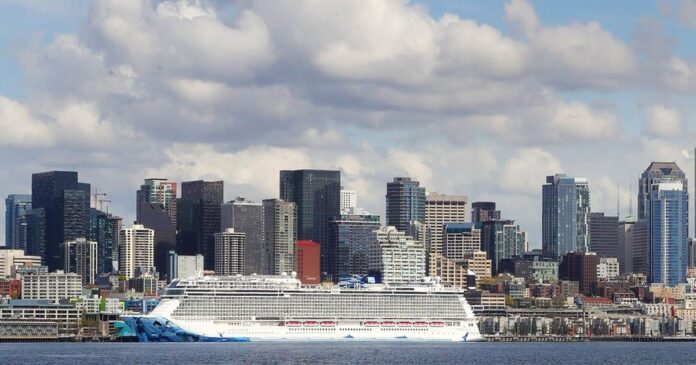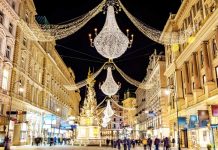If we build it, they will come. Not everyone will like it. But it’s essential to the economy and it’s returning as the nation resumes a tentative normality after the worst of the pandemic.
This, in a nutshell, is the tourism sector in Seattle.
The latest report from the industry association Visit Seattle shows the beginning of a broad recovery after COVID-19 shut down travel, the cruise season and conventions in 2020. The situation barely improved in 2021.
This year, however, hotel occupancy rates were nearly 68% in downtown Seattle in April after being in single digits during the worst of the pandemic. The Seattle Convention Center expects 25 bookings this year after seeing 98 conventions canceled since early 2020, with an estimated loss of $723 million in spending from the events.
AAA predicts that Seattle will be the second most popular U.S. destination for Memorial Day travelers.
This year’s cruise schedule for the Port of Seattle expects 295 planned sailings, with an estimated 1.26 million passengers passing through the two cruise ship terminals. Additional ships to Alaska are being added this year. By contrast, in 2021 the Port saw 82 cruise calls as it implemented a variety of COVID safety protocols.
And all this is happening despite rising inflation biting into earnings, and environmental concerns associated with the industry.
Unlike tourism-dependent places in Florida and the Southwest (especially my hometown of Phoenix), Seattle isn’t all aboard. “Seattle Freeze” Seattleites don’t care for visitors or realize how the city is a major tourist destination. Some especially hate the cruise ships — “Stay away from my city!”
But the reality is that tourism is big business here. More than 181,000 people worked in leisure and hospitality in the Seattle-Tacoma-Bellevue metropolitan area as of April. This number is still below the 209,000 registered in February 2020 before the pandemic, but steadily improving. And this figure doesn’t sweep up more jobs — from restaurants and tour buses to retailing — that depend on the money that travelers spend.
People come for the Space Needle, the Monorail and Seattle Center, Pike Place Market, the Museum of Pop Culture, the Seattle Art Museum, the Seattle Aquarium, the Seattle Great Wheel, Pioneer Square, the Ballard Locks, sports events, world-famous restaurants and many other attractions. Not to mention wonderful summer weather while most of the country broils.
One difference between Seattle and some other big tourism cities is that the economy here is so diversified that it’s not as dependent on that one sector. Here it’s similar to New York City, Washington, D.C., and Los Angeles — as opposed to Phoenix, Las Vegas, San Diego and Orlando, Florida.
Tourism is also relatively new here as a major sector (I’d guess since the Century 21 World’s Fair).
Long before it was the nation’s fifth most populous city, Phoenix coined the term “Valley of the Sun” to lure tourists as part of its recovery from the Great Depression (1930 population 48,000). It succeeded spectacularly, especially in the winter.
In the same era, Seattle had a bustling port, railroads, ship building and canneries on its way to becoming Jet City thanks to Boeing. Then on to Big Tech.
To paraphrase from the 1948 movie “The Treasure of the Sierra Madre“: “Tourists? We don’t need no stinking tourists!” But we do.
Today, tourism has significant downsides in the era of human-caused climate change. Airplanes and automobiles are huge sources of greenhouse gas emissions.
Cruise ships are blamed for numerous environmental problems. Among them: Each ship discharges thousands of gallons of sewage and other pollutants (Washington doesn’t allow this within 12 miles of shore).
The Port of Seattle has a number of initiatives to limit the environmental impact of cruise ships. The Cruise Lines International Association released a recent report committing to reducing its carbon footprint by 40% by 2030 and becoming carbon-neutral by 2050 using alternative fuels, newer ships and advanced technologies.
The trade association includes such giants as Carnival Corporation, Royal Caribbean Cruises, Norwegian Cruise Line and the Seattle-based Holland America Line. Yet the report doesn’t mention how many of the other problems will be addressed.
No wonder why in 2020, Key West, Florida, enacted a permanent ban on the big ships.
It’s a worldwide challenge. For example, a 2021 report from the University of Exeter in the U.K. stated, “Available research suggest that a large cruise ship can have a carbon footprint greater than 12,000 cars. Passengers on an Antarctic cruise can produce as much CO2 emissions while on an average seven-day voyage as the average European in an entire year.”
Yes, people cruise to Antarctica. It’s part of a growing field of adventure tourism for people with more disposable income.
A BBC report listed the “pros” as guidelines enacted to minimize environmental harm and the fact that “tourists learn about the marine biology and threats because of climate change — they may become ambassadors for the area.” But “cons” include increasing numbers of tourists who may unknowingly bring seeds and spores from elsewhere, as well as the danger of pollution.
Which raises the big question regarding a record population of humans and their footprint on a warming planet. Should so many people go so many places, fragile places, by whatever mode of travel? Even if we can, should we?
The answer will have a long-term effect on the industry over which many Seattleites are already ambivalent.










